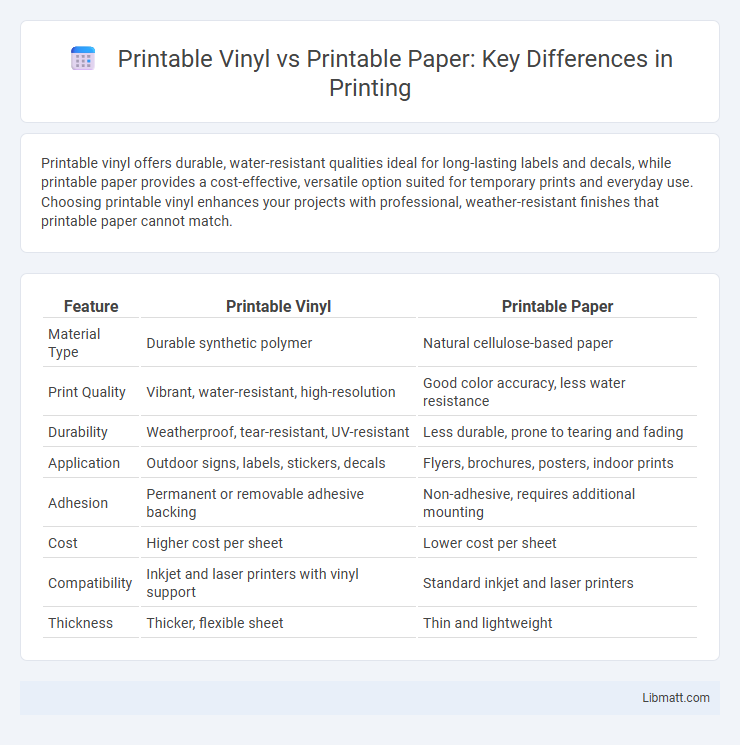Printable vinyl offers durable, water-resistant qualities ideal for long-lasting labels and decals, while printable paper provides a cost-effective, versatile option suited for temporary prints and everyday use. Choosing printable vinyl enhances your projects with professional, weather-resistant finishes that printable paper cannot match.
Table of Comparison
| Feature | Printable Vinyl | Printable Paper |
|---|---|---|
| Material Type | Durable synthetic polymer | Natural cellulose-based paper |
| Print Quality | Vibrant, water-resistant, high-resolution | Good color accuracy, less water resistance |
| Durability | Weatherproof, tear-resistant, UV-resistant | Less durable, prone to tearing and fading |
| Application | Outdoor signs, labels, stickers, decals | Flyers, brochures, posters, indoor prints |
| Adhesion | Permanent or removable adhesive backing | Non-adhesive, requires additional mounting |
| Cost | Higher cost per sheet | Lower cost per sheet |
| Compatibility | Inkjet and laser printers with vinyl support | Standard inkjet and laser printers |
| Thickness | Thicker, flexible sheet | Thin and lightweight |
Introduction to Printable Vinyl and Printable Paper
Printable vinyl offers a durable, water-resistant surface ideal for custom decals, labels, and stickers, making it perfect for outdoor and long-lasting applications. Printable paper provides a smooth, easy-to-use medium suited for indoor prints, flyers, and temporary designs due to its affordability and compatibility with most inkjet and laser printers. Choosing between printable vinyl and printable paper depends on the intended use, durability requirements, and environmental exposure of the final product.
Key Differences Between Printable Vinyl and Printable Paper
Printable vinyl offers water-resistant and durable qualities ideal for outdoor use, while printable paper is more suited for indoor applications due to its lower resistance to moisture and wear. Vinyl typically features a flexible, adhesive-backed surface that adheres securely to various materials, whereas printable paper lacks adhesive properties and requires additional finishing methods like glue or tape. The print quality on vinyl is generally more vibrant and suitable for long-lasting displays, contrasting with printable paper's limited durability and susceptibility to fading.
Durability and Longevity Comparison
Printable vinyl offers superior durability and longevity compared to printable paper due to its waterproof, tear-resistant, and weatherproof properties, making it ideal for outdoor labels and decals. Printable paper, while cost-effective and suitable for indoor applications, tends to fade, tear, and degrade faster when exposed to moisture or sunlight. For projects requiring extended lifespan and resilience, printable vinyl ensures lasting quality and vibrant print retention.
Print Quality and Finish
Printable vinyl delivers superior print quality with vibrant colors and sharp details, thanks to its smooth, non-porous surface that prevents ink absorption. The finish of printable vinyl is typically glossy or matte, offering a durable, water-resistant layer ideal for outdoor and long-lasting applications. Your prints on printable paper may appear less vivid and are prone to fading or smudging due to its porous texture and less durable finish.
Water and Weather Resistance
Printable vinyl offers superior water and weather resistance compared to printable paper, making it ideal for outdoor use and exposure to moisture. Unlike printable paper, vinyl's durable, waterproof surface prevents inks from smudging or fading when wet. This robust resistance ensures longer-lasting prints for labels, decals, and signage in harsh environments.
Ease of Use and Application
Printable vinyl offers superior ease of use for various crafting projects due to its adhesive backing and water-resistant surface, allowing for direct application on materials like glass, plastic, and metal. Printable paper requires additional steps such as lamination or gluing to protect the design and adhere it to surfaces, making it less convenient for durable applications. Your choice depends on whether you prioritize quick, mess-free application or flexibility in printing on traditional paper.
Cost Comparison: Vinyl vs Paper
Printable vinyl generally costs more per sheet compared to printable paper due to its durable, weather-resistant properties and specialty coatings. While printable paper offers a lower upfront cost, its lack of durability makes it less suitable for long-term or outdoor applications, potentially leading to higher replacement expenses. Choosing between printable vinyl and paper hinges on balancing initial material costs with the intended use and lifespan of the printed project.
Best Uses for Printable Vinyl
Printable vinyl is ideal for creating durable, water-resistant labels, decals, and custom stickers that require longevity and vibrant color retention, making it perfect for outdoor and indoor applications. Unlike printable paper, which is best for short-term projects like flyers or temporary decorations, printable vinyl withstands exposure to moisture, UV rays, and wear, ensuring professional-quality results on products like car decals, personalized mugs, and signage. Its compatibility with various inkjet printers and ease of application on curved or uneven surfaces further enhance its versatility for crafting and commercial uses.
Ideal Applications for Printable Paper
Printable paper is ideal for creating vibrant photographs, flyers, and posters that require a smooth surface for high-resolution ink absorption. It works best for indoor projects such as greeting cards, brochures, and detailed graphic prints where durability and water resistance are less critical. Your prints will benefit from printable paper's affordability and ease of use when producing short-term or decorative items.
Conclusion: Choosing the Right Material for Your Projects
Printable vinyl offers superior durability, water resistance, and vibrant color retention, making it ideal for outdoor applications and long-lasting projects. Printable paper is more affordable and easier to use for temporary or indoor items such as flyers and labels. Selecting the right material depends on the project's durability requirements, intended use, and budget constraints.
Printable vinyl vs printable paper Infographic

 libmatt.com
libmatt.com